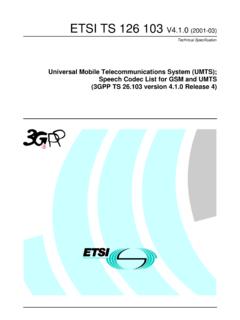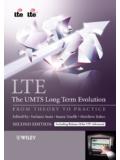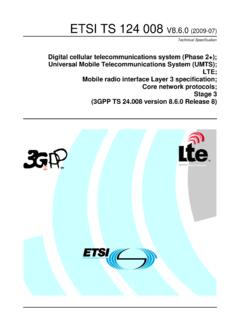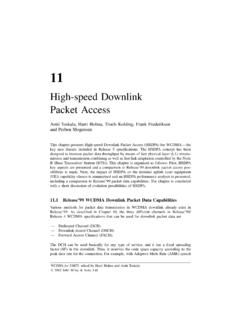Transcription of LTE NETWORK ARCHITECTURE EVOLUTION - Aalto University
1 LTE NETWORK ARCHITECTURE EVOLUTION Ville Eerola Helsinki University of Technology Abstract The aim of this paper is to give an overview of current mobile NETWORK ARCHITECTURE and the step by step approach to the Long Term EVOLUTION (LTE). Also this paper tries to present the advantages why operators are willing to invest to new technology. The path to LTE will include many improvements to NETWORK elements in existing mobile networks. This paper will concentrate also to describe the main functions of the most important NETWORK elements. Key Words Long term EVOLUTION , LTE, UMTS, HSPA, Flat ARCHITECTURE 1.
2 Introduction Nokia Siemens Networks (Nokia Siemens Networks) and UMTS forum (UMTS Forum, 2009) argues that data traffic in existing WCDMA/HSPA and CDMA networks is growing dramatically year by year. This causes a need for mobile operators to update their existing networks to match growing data needs. Building up a NETWORK infrastructure is very expensive and complicated work. Operators demand continuation and backward compatibility from the new innovations which are brought to the networks. This is one of the main factors that current mobile networks are extremely complex and varies between different operators.
3 Journey to LTE will include steps where amount of NETWORK elements is reduced to simplify the NETWORK ARCHITECTURE . These are first steps towards flat ARCHITECTURE . Even with these improvements the LTE NETWORK will be complex because symbiotic relationships exist between the various elements within the system. (Nokia Siemens Networks) Operators are looking for wider bandwidth, efficiency and lower costs from their networks. From the picture 1 it is easy to see that there is a high pressure to move from circuit switched networks to packet switched networks to lower the cost per bit.
4 LTE is an important evolutionary step that builds on GSM/EDGE and WCDMA/HSPA to make higher data rates for mobile broadband services economically viable. Also LTE allows the possibility to use wide range of bandwidths. (Nokia Siemens Networks) Picture 1: The cost per bit must be reduced for operators to remain profitable (UMTS Forum, 2009) 2. Background of LTE During 2004 3rd Generation Partnership Project (3 GPP) started to investigate requirements for UMTS Terrestrial Radio Access NETWORK (UTRAN) LTE. Workshops were held with many telecommunications industry players.
5 During these workshops it was agreed that feasibility study for new packet-only radio system will be started. During the feasibility study following key requirements was defined for the new system (Holma & Toskala, 2007) (UMTS Forum, 2008): Packet-switched domain optimization Roundtrip time between server and user equipment (UE) must be bellow 30ms and access delay below 300 ms Uplink peak rate 75 Mbps Downlink peak rate 300 Mbps Improvements to mobility and security Terminal power efficiency improvements Wide frequency flexibility with , 5, 10, 15 and 20 MHz allocations Capacity increase compared to 3 GPP release 6 (HSDPA/HSUPA) LTE technology has many benefits when compared to current 3G networks.
6 UMTS Forum (UMTS Forum, 2008) describes that from a technical point of view, the main objective of the LTE project is to offer higher data rates for both down- and uplink transmission. Another main improvement for LTE is to reduce packet latency. By reducing latency responsiveness of gaming, VoIP, videoconferencing and other real-time services are improved greatly. Dr. Michael Schopp (Schopp) defines that the main benefit of LTE is that it can deliver services at fixed line quality with cost of IP technologies. 3G Americas (3gamericas) argues that main benefit of LTE is the simplified and flat all IP ARCHITECTURE which helps to reduce both latency and cost of the NETWORK .
7 Dahlman et all (Dahlman, ym.) defines that the benefits of LTE comes from increased data rates, improved spectrum efficiency, improved coverage, and reduced latency. Table 1: Uplink and downlink data rates compared for HSPA and LTE (UMTS Forum, 2008) Based on all of these we can say that the LTE will bring benefits for many areas compared to current telecommunications networks. However the biggest competitive affect from the NETWORK operator point of view will be its reduced cost per bit. Market for UMTS/HSPA is estimated to grow until 2013 but it is good to remember that LTE networks are not in that far in the future.
8 Some LTE networks are already ramped-up DoCoMo in Japan has a prototype LTE NETWORK (Fierce Broadband Wireless, 2009). Picture 2 presents a basic timeframe for different NETWORK improvements. Picture 2: EVOLUTION timeframe for NETWORK systems (Nokia Siemens Networks) 3. LTE technology To reach the higher data rates and faster connection times LTE contains a new radio interface and access NETWORK . During 3 GPP organized workshops it was agreed that the technology solution chosen for the LTE air interface uses Orthogonal Frequency Division Multiplexing (OFDM).
9 Also to reach the agreed data levels multiple input / multiple output (MIMO) technologies, together with high rate modulation were agreed. (UMTS Forum, 2009) LTE uses the same principles as HSPA for scheduling of shared channel data and fast link adaptation. This enables the NETWORK to optimize cell performance dynamically. LTE does not contain dedicated channels carrying data to specific users because it is based entirely on shared and broadcast channels. This increases the efficiency of the air interface as the NETWORK no longer has to assign fixed levels of resource to each user but can allocate air interface resources according to real time demand.
10 (UMTS Forum, 2009) OFDMA 3 GPP needed to make quite radical changes to LTE radio interface because enhancements to WCDMA technology could cause major problems with power consumption. Also the processing capability required in LTE would have made the resulting technology unsuitable for handheld mobile devices. OFDM-based technology was chosen because it can achieve the targeted high data rates with simpler implementations involving relatively low cost and power-efficient hardware. (UMTS Forum, 2009) It is good to notice that OFDMA is used in the downlink of LTE but for the uplink Single Carrier Frequency Division Multiple Access (SC-FDMA) technology is used.








